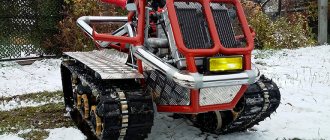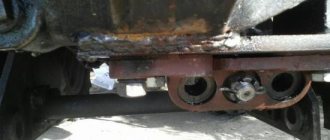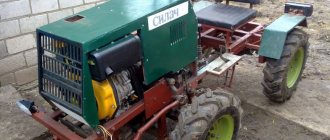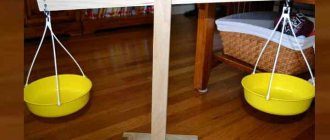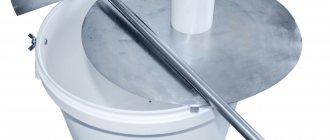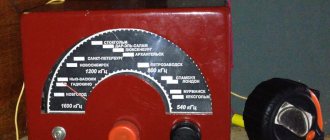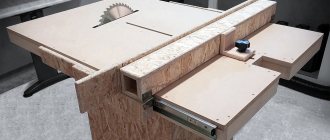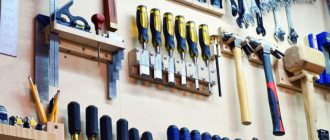A modern “Ant”, assembled according to the drawings of the “Modelist-Constructor” magazine.
Despite the two decades that separate today from the rich Soviet past, the seeds of extraordinary, creative ideas still sprout in the field of modern capitalism and sometimes bear good fruit. Our country inherited homemade trucks as a tradition, because in the modern world, the car and the driver are separated by the most complex mechanical engineering technology, electronics, and numerous and expensive tools. And the products of the Soviet automobile industry pushed the driver to modernize, although not always effective, but with a completely understandable design, practicality of the device, and ease of modernization.
A truck with an IZH engine: from the Volga and Moskvich-407 cars, it is proposed to take semi-elliptical springs, having first shortened them, and make the rear suspension spring, independent.
Just remember the now famous products of the Tula Machine-Building Plant under the unassuming name “Ant”. One type of this wheeled vehicle makes one think about making a flatbed truck based on a scooter. By the way, the first “Ant” (not TG-200) was assembled by hand in 1966 by home-made workers Ivchenko and Molchanov. The Java-350 engine located behind the rear axle made it possible to lower the center of gravity and, together with the carriage layout, make the body more stable on the road. With a power of 14.3 hp. (4500 rpm), this homemade mini-truck developed up to 70 km/h, and its diagrams were published in the “Modelist-Konstruktor” magazine for the 70th year.
And indeed: scrapped mopeds and motorcycles are the basis for most of these crafts. This is probably due to the fact that the design of a moped is easiest to adapt to everyday needs: there is no need to tinker with a complex transmission - you attach the body and go. Homemade mini trucks are assembled not to admire them as a work of art (although this also occurs), but because this type of transport is a wonderful assistant in the household.
Homemade mini truck
Fig.1.
Appearance of a homemade mini truck. This mini truck differs from many of its other brethren in its simplicity of design and reliability in operation (its speed is up to 70 km/h). It is quite possible to build it at home.
The spacious, bright cabin with panoramic front glass provides good visibility and protects the driver from bad weather. The rather convenient location of the engine under the car body increases the usable area of the cabin and body.
Overall dimensions of a homemade mini truck:
— Length — 2380 mm, — width — 1210 mm, — height — 1450 mm, — ground clearance — 230 mm, — track width — 960 mm.
Fig.2. Overall dimensions of a homemade mini truck.
The truck has a rectangular welded tubular frame measuring 2380 x 490 mm. In its central part, a two-stroke engine from an IZH-56 motorcycle with a power of 14 hp is installed on two plate brackets. With. (10.3 kW). However, another similar one will do. You never know what “pieces of hardware” have accumulated in home workshops and sheds over the decades!
The front suspension has two shortened semi-elliptic springs (from Volga or Moskvich-407 cars in 2 leaves) with dry mechanical friction-type shock absorbers. The front axle is solid, with steering axles on the axle shafts. The hubs of the front steering wheels rotate on these axle shafts on paired ball bearings.
Fig.3. Front view and rear view (sectional).
Rear suspension - independent, with coil springs and friction-type mechanical shock absorbers
Torque is transmitted to the rear wheels through a gearbox with a differential mechanism and a reverse gear shift unit. Rotation from the engine to the gearbox is transmitted by a roller chain.
The car's brake mechanism is installed only on the rear wheels.
Braking is performed using a foot pedal and a handbrake lever with a parking lock from the driver's cab.
The car's cabin is a two-seater cabin, made of duralumin by riveting.
Cabin height is 1250 mm, width - 1200 mm, length - 1300 mm.
On the left side of the cabin there is a steering wheel, clutch pedal, brake pedal and gas pedal, to the right of the driver there are two handles: gear shift and hand brake. In the front part of the cabin in front of the driver there is an instrument panel on which the ignition switch, light switch, speedometer, gas meter, and ammeter are mounted. There is also a 2-band semiconductor radio receiver.
There is a lamp mounted in the rear wall of the cabin to illuminate the cabin.
At the front, the car is equipped with headlights with low and high beams. Under the headlights there are oblong sidelights - direction indicators.
The electrical equipment of the car is designed for a voltage of 6 V, battery powered, with recharging from the engine generator. The windshield is equipped with a mechanical wiper.
An air intake with a fan for cooling the engine is installed under the cab floor, which is located behind the cab under the car body.
Fig.4,5. The main components of a homemade mini truck. 1 — hand brake, 2 — gear shift knob, 3 — air cleaner, 4 — body mounts, 5 — steering linkage, 6 — muffler, 7 — friction damper, 8 — independent rear axle suspension, 9 — frame, 10 — rear spring suspension, 11 - battery, 12 - IZH-56 engine, 13 - clutch pedal, 14 - steering gear, 15 - hand brake pedal, 16 - engine starting pedal, 17 - gas pedal.
The car body is made of light wood with a duralumin corner edging. It is made in the form of an onboard cargo area with a folding tailgate and a tarpaulin awning. The body is mounted on the frame using four rods inserted into the frame pipes and secured with four locking bolts. For the transportation of liquids or bulk cargo, the loading platform can be replaced by a tank or a self-dumping tray, and for the transportation of people - by a bus-type body.
Under the body, on a bracket welded to the frame, a fuel tank with a capacity of 12 liters is placed, which ensures a vehicle range of over 200 km without refueling.
The wheels for the car are taken from a wheelchair. However, you can also install wheels from scooters on it. The design uses some standard components from a motorized stroller, such as the rear axle, steering and others. This makes building the car much easier.
Soviet trucks: what can be made from cars (22 photos)
STRONG BUT LIGHTWEIGHT
The first Soviet pickup truck was the 1932 NATI-2. The prototype of this car was made at the same time as a convertible and a roadster. People's cars with 22-horsepower engines were planned for production in Izhevsk to replace the simple NAMI-1, which was assembled semi-handicraft in small quantities in Moscow. It didn't come true.
But a year later, in 1933, the Gorky Automobile Plant began mass production of the GAZ-4 pickup truck with a declared load capacity of half a ton. Following this car, built on the GAZ-A basis, a cargo version of the Emka, the GAZ-M415 with a carrying capacity of 400 kg, went into production. It’s interesting that the first Soviet pickups were closer not to their modern counterparts, but rather to station wagons without a roof. After all, in the bodies of GAZ vehicles along the sides there were folding benches for six passengers. Surprisingly, this design (albeit in a slightly different form) will return to the Soviet automobile industry half a century later. In the meantime, in the 1930s, homemade booths were sometimes installed on pickup trucks, making the vehicles vans, and some small businesses created their own versions (somewhat ugly, and sometimes quite attractive) of light-duty vehicles.
They planned to develop a family of pickup trucks based on the Emka. In 1940, the GAZ-11-415 prototype was ready with a new 6-cylinder 76-horsepower engine and other changes. They planned to build an all-wheel drive version of the GAZ-61-415 with the same “six”. Such a machine, of course, was very much needed by the military, and ordinary rural residents of the USSR, of course, would not refuse it. But the war began. In the fall of 1941, less than four dozen simplified GAZ-11-417 pickup trucks were made without a roof and with canvas doors. All these cars died in 1941, and only recently restorers made a copy of this model.
After the war, the history of Gorky cars of this class was cut short for decades. Neither Pobeda nor Volga simply had time for this. After all, they performed nomenklatura functions, worked in taxis, and entered the retail chain. But the Gorky plant simply could not increase production.
However, the GAZ-22A van with a carrying capacity of 500 kg was built on the basis of the GAZ-22 station wagon. The car was shown at VDNH (many experimental cars were brought there in the early 1960s), they wrote about it in the press, but they never put it into production. In 1978, the experimental van GAZ-24-76 was even made on the basis of the GAZ-24. But it’s very difficult to imagine a truck based on the most prestigious and coveted Soviet car.
Only during perestroika, when the concept of prestige and the demand for cars changed, the plant returned to this topic again, building the GAZ-2304 Burlak model. In addition to the pickup truck, it was planned to install various cargo superstructures, say, an isothermal van, on the semi-frame behind the cab, which represents the front part of the Volga GAZ-31029. But this car did not go into production either. And ten years later, something similar under the name “Trofim” was briefly made by a small company in the Tula region. The strange design disappeared from the market even before the Volga, which was living its last days.
WORKING CLASS
Another thing is “Moskvich”! The democratic car was destined to become a truck. That's what he became. All models, starting with the post-war 400, had factory-produced cargo modifications with a lifting capacity of 250 kg. At the end of the 1950s, they even made a prototype of an all-wheel drive van based on the Moskvich-411 station wagon. He didn't make it into the series. But the standard “Muscovites” vans became an integral part of the urban landscapes of the 1960s - 1980s. The Moskvich-434 with a 75-horsepower engine from the 412 even had a right-hand drive version, since in the early 1970s Moscow cars sold well in the UK.
By the way, they also made a right-hand drive pickup truck there. Such models were in demand in Albion, but AZLK itself did not produce them. In our climate and lifestyle, pickup trucks were rightly considered less practical. The plant made them from defective bodies only for its own needs. Other pickups seen on the streets are folk art, which will be discussed later. The first serial Moscow pickup truck was the Moskvich-2335 based on the 41st.
It would seem that a tall van is a completely logical derivative of a light-duty truck. But the idea of the Izhevsk Automobile Plant was very difficult to pass through in the management offices. After all, the enterprise was not subordinate to the Ministry of Automotive Industry and was supposed to produce cars only according to AZLK tracings. More or less serious changes to their design took place with difficulty. Moreover, it’s a car with a significantly redesigned body. And yet, IZH-2715, which was quickly nicknamed the “heel” by the people, appeared. The vehicle was designed for 600 kg of cargo, had a much larger body volume than Moscow vans and was, of course, more convenient for loading and unloading. On early versions there was the inscription “1500 grams” on the back, which drivers interpreted as “1500 grams”, meaning not the carrying capacity at all.
Pick-up trucks were also made on the basis of the Izhevsk “heel”, but in much smaller quantities. Among the most interesting serial modifications is the IZH-27151-013-01 pickup truck with an extended platform, created for export markets, primarily Finland and, of course, IZH-27156. The back of this van had sliding glass windows and folding benches on the sides. To a certain extent, the car became the heir to the pickup trucks of the 1930s, but in the perestroika Soviet press the model was somewhat slyly called a “high-capacity station wagon” and compared with tall imported station wagons, which briefly became fashionable in the 1980s.
It became the first commercial VAZ van. electric car! VAZ-21029 (at the design stage - VAZ-2102E). Two cars were made in 1975 based on the 2102 station wagon. The electric motor developed 25 kW (34 hp), and the batteries weighed 380 kg. The body of the “two” turned out to be weak for such a load. We made a version with an aluminum frame. 47 such vehicles were built under the name VAZ-2801 in the early 1980s. The vans with a carrying capacity of 320 kg were given to various enterprises for trial operation. But they were not released anymore.
The first VAZ truck based on the Niva appeared already in perestroika times. An onboard car under the name “Bison” was produced by one of the VAZ subsidiaries, which in those years began to multiply one after another. Well, relatively recently, several models of pickups and vans based on the Niva, Five and Samara began to be produced by the VIS company. By the way, the version based on the VAZ-2105 arose from an in-plant pickup truck, which was made for production needs. This is how, by the way, some other Soviet models were born.
CHILDREN OF A HARD DESTINY
Not all cars are as lucky as the VAZ ones. Of course, it was very tempting to make a light truck based on the all-wheel drive GAZ-69. The Ulyanovsk plant diligently worked on such modifications, even building a dump truck and a truck tractor, which was completely unusual for this class. All this was not destined to become serial. As well as a van based on the then promising UAZ-469. They tried to produce cargo versions based on the UAZ-3151 already during the perestroika years, but the first production pickup truck appeared much later, as a relative of the Patriot model.
Homemade mini-trucks: diagrams, drawings, tips
A modern “Ant”, assembled according to the drawings of the “Modelist-Constructor” magazine.
Despite the two decades that separate today from the rich Soviet past, the seeds of extraordinary, creative ideas still sprout in the field of modern capitalism and sometimes bear good fruit. Our country inherited homemade trucks as a tradition, because in the modern world, the car and the driver are separated by the most complex mechanical engineering technology, electronics, and numerous and expensive tools. And the products of the Soviet automobile industry pushed the driver to modernize, although not always effective, but with a completely understandable design, practicality of the device, and ease of modernization.
A truck with an IZH engine: from the Volga and Moskvich-407 cars, it is proposed to take semi-elliptical springs, having first shortened them, and make the rear suspension spring, independent.
Just remember the now famous products of the Tula Machine-Building Plant under the unassuming name “Ant”. One type of this wheeled vehicle makes one think about making a flatbed truck based on a scooter. By the way, the first “Ant” (not TG-200) was assembled by hand in 1966 by home-made workers Ivchenko and Molchanov. The Java-350 engine located behind the rear axle made it possible to lower the center of gravity and, together with the carriage layout, make the body more stable on the road. With a power of 14.3 hp. (4500 rpm), this homemade mini-truck developed up to 70 km/h, and its diagrams were published in the “Modelist-Konstruktor” magazine for the 70th year.
And indeed: scrapped mopeds and motorcycles are the basis for most of these crafts. This is probably due to the fact that the design of a moped is easiest to adapt to everyday needs: there is no need to tinker with a complex transmission - you attach the body and go. Homemade mini trucks are assembled not to admire them as a work of art (although this also occurs), but because this type of transport is a wonderful assistant in the household.
General principle
Most often, the base of a homemade mini-truck consists of a welded tubular frame, in the central part of which there is an engine. The motor can be removed from any old motorcycle or moped. The cabin is made from parts of old cars. Since all transmission parts are usually borrowed from other cars, the control levers and pedals are usually located on the right side of the cabin.
Wheels are most often combined (processed machine wheels, with motorcycle wheels or even cart wheels). Masters of such homemade designs for helmsmen recommend using motorcycle and scooter tires. Wheels are selected depending on the driving conditions. Homogeneous and dual wheels are suitable for smooth, unproblematic roads. While wide-profile motorcycle tires are suitable for off-road driving or simply difficult sections of the road.
The homemade truck is driven by an engine from a walk-behind tractor without a muffler, the body is made of lumber, and the wheels are made of low-pressure tires. The disadvantages of the design are front-wheel drive and heavy steel wheels.
The easiest way to assemble a homemade truck body is from lumber: they are inexpensive and do not require any special equipment for installation. Of course, the body can be removed from a tractor or any other vehicle, but you need to take into account its weight and dimensions - such a body is subject to modification. A good welding machine opens up wide possibilities, the presence of which makes it possible to weld a body frame in the garage.
Incredible homemade products: vehicles built by the golden hands of auto enthusiasts
Sometimes there is not enough money for a car, especially during a crisis, but you really want to have your own vehicle. Some craftsmen with golden hands get out of this situation quite simply: car enthusiasts build new ones from old cars. Just take a look at these projects:
Quad 4x4 "Scoop"
Apparently, the author of this VAZ 2109 ATV was not satisfied with how public utility workers remove snow. Taking all his hands, he built this unit. The engine is from a VAZ 21081, the axles are from a Moskvich 412, the lower suspension arms are figure-eight, the upper arms are homemade, the front rear shock absorbers are from a VAZ 2108, the rear rear shock absorbers are from ZAZ, the frame is made from profile pipes. Now look at how the Quad 4x4 “Scoop” copes with clearing snow.
Diggati
Meet Diggati with a 1.7-liter engine from a VAZ 2103. Its owner first wanted to build a buggy, and then a compact SUV. But due to a lack of money, we got this little car called Diggati.
Baby 4x4
“Baby”, this is what the author of this project calls his all-terrain vehicle. Volga with huge wheels on civilian bridges from UAZ, engine and gearbox from VAZ 2109, transfer case from Niva. Niva.
Bar stool with motor
It took exactly two months to build this vehicle. The motorized bar stool accelerates to 80 km/h. The device is equipped with hydraulic brakes from an ATV and some parts from a go-kart.
Triton-1
The Triton-1 all-terrain vehicle was built to make it possible to less carefully plan the route of a fishing trip in the part that concerns roads. The engine here is a 1.5-liter with a capacity of 68 hp. from VAZ 21083. The maximum speed of the 950-kilogram unit is 35 km/h.
Homemade product without a name
The project has not yet been completed, but already now it is arousing interest among many and attracting enough attention. There are practically no details about him. It is known that the ZAZ 968m was taken as the basis for the unnamed car.
Our craftsmen can assemble a vehicle from absolutely anything. Here, for example, is a super tricycle from a bathtub and an off-road car from a helicopter
There are also such instances. The imagination of the craftsmen is simply amazing!
But from several GAZ trucks you can make such an off-road monster.
Frames, axles, and transfer cases were taken from two GAZ-66 cars. Two bodies of a Gazelle car, a cab from a GAZ-3307, tires from a combine harvester. The result was a big, powerful, fast, beautiful car.
Frame for a homemade truck
In the general stream of frame structures offered by modern Kulibins, one can distinguish breakable and monolithic frames. The idea of a breakable frame pursues two goals at once - achieving high mobility and combining elements of different cars in one design. So the frame consists of two parts, connected to each other by a hinge. The latter is most often a universal joint removed from another truck. However, such a mount can move in any direction, and its degrees of freedom must first be limited to “right-left” by welding lugs to the edges of the cardan cross.
How to make a truck with a trailer from a LEGO constructor: instructions, diagram, description
Truck with trailer
You can build whatever your heart desires from Lego; mobile transport is especially popular; many have been interested in construction toys since childhood and carry their hobby into adulthood, collecting their products.
After assembling the truck, you can play with it, imagining yourself as a truck driver. You can come up with the color and decor of the design yourself. The widest selection of Lego parts allows you to add any detail to your product.
Truck
To create a homemade simple truck from Lego you will need:
- 1 piece 1*10
- 3 parts 1*2 with longitudinal ring
- Part 1*4
- 2 parts 1*3
- 2 parts 2*3
- 1 flat cube
- Single cube
- 2 single cubes with fasteners
- 1 single cube with loop
- 1 piece 1*2
- 1 piece which consists of 3 single cubes placed in an L shape
- Flat part 2*2
- 2 flat parts 1*2
- 2 horn-shaped parts
- Single beveled part
- 11 wheels
- 2 tires per wheel
- Headlights 3 pcs.
- Wheel mounts
- 2 corners with one hole
- Lattice
- Part 2*1 with one convex part
Such transport can be made according to these instructions indicated in the video.
Engine
As noted above, the main driving force of homemade mini-trucks is motors from mopeds (Soviet magazines recommended using the IZH-56 engine), and low-power boxer engines. The advantage of the latter is the ability to lower the center of gravity and low vibrations, which becomes important when it comes to a heavy body mounted on a passenger chassis. Engines from standard power plants (UD-4, UD-2, etc.) are popular. It is sometimes easier to get diesel and gasoline engines from stations than to recover scrap, but power units from passenger cars are also found in homemade designs.
It is difficult to imagine that a homemade truck will require good dynamics and acceleration. Torque is critical when choosing, but some high-speed engines can be used in conjunction with a reduction gearbox. At low speeds, four-stroke diesel engines demonstrate a good N˙m value. And in the diagrams you can often see ZAZ power units, but what is more important is that they can also often be found on actually working equipment. The durability of these engines, equipped with a good, by the standards of our reality, atmospheric cooling system, is worthy of special mention.
Tractor engines from T-16, T-25, etc. have proven themselves quite well. Motors like the D-21A1 can be easily adapted for domestic needs: power - 25 hp, maximum rpm - 1800. However, the standard starter from these engines may not work Russian cold weather, so the original starter is often replaced with a starter from the T-40. Additionally, the motor can be improved by adding a cardboard filter to it, and given its dimensions, it is better to place it behind the cabin. Engines from the T-16 can be connected to the GAZ-51 gearbox using the original clutch, although in this case you will need to use a sheet metal adapter with holes for the mount and shaft.
Popular models
Loader cranes are produced in:
You can choose a power plant model from the following brands of leading global manufacturers:
Foton units have a load capacity of 6 tons, and their length is more than 6 m. Foton Ollie transports goods and is useful in construction work.
The Isuzu QL 1100 TMA crane installation is one of the new products of the Japanese company. Load capacity - 5.5 tons, length about 6 m.
The Hiab 600EP5HiPro loader crane lifts loads up to 16 tons. It can be used to move large and oversized loads. Equipped with a remote control. This device is capable of lifting loads that are located near its wheels.
The mini crane moves loads weighing up to 3 tons. Popular models:
- SOROKIN 8.10.
- AE&T 1t T62201.
- AE&T 1t T62101.
- SOROKIN 8.6.
- SOROKIN8.2.
- SOROKIN 8.22.
- SOROKIN 8.3.
A suitable crane installation for Gazelle should lift a weight of 800 kg. These are the following models:
- RM 3622 CE, manufacturer - Italy, mounted behind the cabin;
- Unik URA - 100, manufacturer - Japan, mounted inside the on-board platform.
The Gazelle with CMU is suitable for transporting large and light cargo, as well as for loading and unloading operations.
Source
Transmission
The wheels on homemade trucks are most often not original ones, so the standard gearbox sometimes cannot provide the required force. A way out of this situation may be to use a rigid box from GAZ (models 53 and 51) together with a low-power engine T-16, M-72, etc. In this case, the truck drawing usually includes an adapter made of a metal plate. The need for such a design arises due to the difference in size of the gearbox input shaft and the crankshaft of the power unit.
The easiest way to use mounted systems is to use homemade or hydraulic ones, and with this there is a need to include a power take-off in the transmission. The selection box can be shared by agricultural machinery or a recycled all-terrain vehicle. Completely remaking bridges is problematic, but by shortening the axle shafts and “stockings” you can change the dimensions of the base and the track size. Seats for axle shafts and bearings can be easily moved to another point in the frame, but this procedure must be accompanied by strengthening the welding site.
The designer's platform is a pure MAN KAT chassis.
Design
The most logical place to start searching for parts is the axles and engine. The frame, suspension, etc. will depend on the capabilities of the engine and the dimensions of the transmission. In the simplest version, all the parts are simply laid on a flat surface, and the frame is welded based on the distance between the axles. It is recommended to use standard frames from the GAZ-53, which can easily be shortened or equipped with additional cross members, fork bars, shock absorber struts, suspension travel limiters, side members, etc.
It is better, of course, to use preliminary diagrams and drawings. Homemade trucks are assembled from factory parts, so all dimensions must be known, and it is not impossible to write out all the calculations on paper in advance. The standard engine may require modification due to the need to connect to a non-original gearbox; the gearbox does not always allow you to work freely with the wheels and motor at hand, but optimism and preliminary planning help Russian craftsmen cope with any difficulties.
Truck assembly diagram in pictures
Lego constructors help children develop logical and spatial thinking, the materials are made from environmentally friendly materials, and the parts have a rounded, safe shape for children of a certain age.
It’s easy to build a truck if the chosen set is appropriate for the child’s age, but even if the design is complex and the child can’t handle it on his own, the whole family can join in and help.
